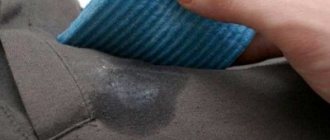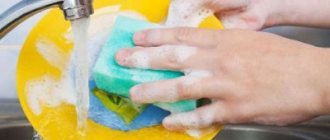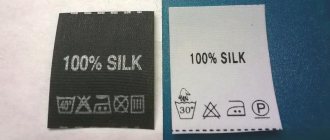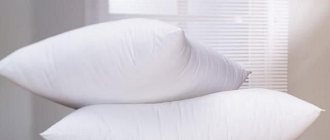Hats, like other clothes, lose their shape, shine and attractive appearance over long periods of use.
This problem can be corrected by starching the product. After this procedure, the headdress acquires its original appearance. In our article we will tell you how to properly starch a hat at home?
Why do you starch a hat? Starching the product has the following effects: - restoration of the original shape of the hat; — increasing the density and elasticity of threads; — the headdress does not wrinkle; — a protective layer is formed on the fabric; — service life increases.
What is required to carry out the procedure
Before the procedure, you should prepare the necessary things so that they are at hand. In order to starch a hat, you will need to prepare the following materials in advance:
- Small basin;
- Measuring utensils;
- A tablespoon;
- Medium sized saucepan;
- Glass or cup.
In addition, you will need to purchase a product that will be used to process the item.
You can starch an item using the following means:
- Starch, it is best to take it for the procedure;
- PVA glue, it can only be used on light-colored things;
- Sugar;
- Gelatin;
- Milk.
To starch things, it is better to use special sprays, since using other means can spoil the thing, for example, PVA glue and gelatin leave white stains on colored and dark hats, and sugar starching can attract insects.
However, if you don’t have time to look for a special spray, then you can replace it with starch, which can be purchased at any store.
Other methods of starching
When buying starch, you can opt for an already diluted product or in the form of an aerosol. But the method using starch powder is more reliable and cheaper.
Starch the tape using a spray with a similar effect. It should be sprayed from a distance of 20-25 cm, having first studied the attached instructions. After drying, iron. The tape will acquire shine, smoothness and strength.
Liquid starch sold in retail chains cannot be boiled. Just pour it into a container and dip the tape into it. After 5-10 minutes, remove the tape, dry it, and then iron it.
Starching things is a delicate task. By going too far with the concentration of the starch substance, you can get unbending clothes that will be difficult to “bring to your senses”
It is important to follow the recipe, take into account the structure and size of the fabric, and set the correct shape. You may not be able to starch the item perfectly the first time.
If the housewife doubts her abilities, then it is better to practice on unnecessary pieces of fabric.
Degrees of starch
It is recommended to treat a light summer hat with starch, as it does not leave yellow stains. Before starting the procedure, you need to determine the required degree of starch, there are 3 of them:
- Low level is suitable for items made of light fabric. Low starch levels are mainly used for curtains, bed linen, curtains, summer dresses and shirts. In order to obtain a low degree of starch, more water is poured into the solution, the proportions should be approximately the following: 1 tsp. for 1 l. water;
- Medium degree, suitable for items made of thick fabric: skirts, trousers, thick ribbons and tablecloths, it is also suitable for processing knitted and woolen items, and for hats made of soft fabrics. To process the item, a mixture is made in which the concentration of starch is increased, 2 tsp is taken. for 1 liter of water;
- High degree. This degree is used for processing items made of coarse fabric: hats, petticoats, denim. In this case, a mixture is used in which the concentration of starch is 2 tablespoons, and borax is also added to it. This concentration of starch makes it possible to give the item a stable position, so stand-up collars are mainly treated with this mixture.
Before starting the procedure, it is necessary to determine the density of the fabric and what degree it needs: caps made of soft fabrics should be treated with a medium degree solution, and caps made of dense fabrics should be treated with a high degree solution. Let's take a closer look at how to starch a hat.
Why is this necessary?
Starching hats has the following effects:
- the shape of the headdress is restored;
- the elasticity and density of threads increases;
- the product does not wrinkle;
- a protective layer is created on the surface of the fabric;
- the service life of hats increases.
This procedure can be applied to straw and other types of hats. The effect will be the same in each case.
The main disadvantage of this procedure is that to achieve the desired result, you must strictly follow the given recipes.
Moreover, similar problems often arise with crocheted hats.
Using starch for the procedure
You can starch a hat as follows:
In order to starch an item with a low degree of starch, you need to prepare the following mixture: 1 liter. warm water should be mixed with 1 tsp. starch, the mixture should be homogeneous. In a separate pan, you need to boil the required amount of water, as soon as it boils, you need to pour the starch mixture into it, pour it in slowly, stirring constantly. After this, you need to let the mixture cool, and you need to put the cap in it. You need to keep it in the water for a couple of minutes, then carefully take it out and put it on a thick ball of the right size or on a bottle. You cannot simply hang a hat to dry, as its shape may be ruined. After this procedure, the hat will retain its shape and remain clean.
In order to starch a hat with a medium solution, it must be prepared in the same way, but only 2 tsp must be added to the mixture. powder.
Hats made of dense and rigid fabric must be starched with a highly concentrated solution.
To prepare the solution you need to take 2 tbsp. starch and do everything as usual. The hat should be kept in this solution a little less, since a long stay of the item in the starch mixture can ruin the item. After soaking, the hat should also be put on something, and after drying, its brim should be ironed.
If there is no special means for carrying out the procedures, then it is better to use starch. It is important to prepare the mixture correctly and after soaking, the item must be put on a voluminous object so that it takes the desired shape.
What is starch?
How to dilute starch for starching, and how does the whole procedure take place? Initially, you will agree that if you wash a lot of things, you will need several paste solutions. It is unacceptable to use one paste for both linen and a chef’s hat.
Depending on whether you want to starch the item just a little bit or you need it to hold its shape firmly, use different concentrations of solutions (change the proportions of water and starch). But the sequence of the procedure itself remains unchanged and consists of five steps.
- Starch is poured into a small container and poured with a glass of cold water.
- The mixture is carefully kneaded so that no lumps remain.
- The remaining water according to the recipe is poured into the pan and brought to a boil.
- Pour concentrated starch into the bubbling liquid in a thin stream with constant stirring and immediately turn off the heat.
- The resulting paste is allowed to cool under natural conditions.
Soft solution
Peculiarities. The soft method provides elasticity to the products and gives a slight characteristic crunch. But such a procedure will not allow the thing to “keep its shape”. This fabric will not be hard to the touch.
Used for:
- chiffon dresses;
- women's blouses, blouses;
- bed linen;
- medical gowns;
- men's shirts;
- gauze, cambric.
Components:
- starch - two teaspoons;
- water - two liters.
Progress of the procedure
- The solution is poured into a basin.
- Washed laundry is dipped into the paste for literally one or two minutes.
- The products are taken out and wrung out.
- Then shake and hang to dry.
- When hanging the product, be sure to remove all folds and creases.
You should not use heating devices to dry starched products.
Medium hardness
Peculiarities. If lumps have formed in the starch solution, it must be filtered before use. You can strain the warm mass through a sieve or cheesecloth.
Used for:
- napkins, tablecloths;
- furniture covers;
- curtains;
- shuttlecocks;
- school aprons;
- lace;
- bows;
- denim boots (only light ones).
Components:
- starch - two tablespoons;
- water - two liters.
Progress of the procedure
- To add shine to the product, add half a teaspoon of kitchen salt to the solution.
- Washed clothes are immersed in the paste, removed after a minute and wrung out.
- Hang to dry, straightening folds and shaping.
Saturated paste
Peculiarities. As reviews show, this recipe can be used without adding borax. In this case, it is recommended to take more starch (plus two tablespoons) and use the classic technology for making a solution.
Used for:
- collars and cuffs of men's shirts;
- decorative fabric flowerpots;
- tutus (skirts) that need strong fixation;
- petticoats for fluffy dresses;
- chef's or paramedic's hats;
- fabric decorative flowers;
- some crocheted items (for example, boots).
Components:
- starch - three tablespoons;
- borax - two teaspoons;
- water - two liters.
Progress of the procedure
- Starch is diluted in a glass of cold water.
- Borax is first dissolved in a glass of hot water and cooled.
- The remaining water is boiled.
- Starch concentrate is carefully poured into it.
- Then the borax solution is added. The fire is turned off. The mixture is thoroughly stirred.
- The paste is infused for two hours.
If during the preparation of the paste it acquires a grayish tint, it is recommended to boil the solution over low heat for five minutes. And the mixture will immediately become light.
Using PVA glue
If you don’t have starch on hand, you can use PVA glue to carry out the procedure. This method of starching can only be used on light-colored hats, since the glue leaves stains on colored items. You need to work with glue as follows:
First of all, PVA must be diluted with water, in a ratio of 1 to 1, but it is necessary to take into account the type and quality of the glue; if it is liquid, then less water must be added. The water temperature can be any, but it is best to take water at room temperature. It is recommended to mix the substances in a large saucepan. After the mixture is ready, you need to put the cap in it and give it time to soak. After this, it must be carefully pulled out and squeezed out. And at the very end, it must be put on an object of the desired shape so that it dries.
This method of carrying out the procedure is quite simple, but you need to act carefully, otherwise the item will be damaged. It is also important to choose a good and high-quality glue; it is forbidden to use glue that has expired.
In order to give the hat a beautiful look after the procedure and after it has dried, it is recommended to iron it. The cap must be ironed through gauze.
How to starch things at home: 3 methods
Housewives can starch things with potato starch or another substance either manually or using an automatic washing machine, as well as using special ironing products.
Manually
Peculiarities. The recipe for manual starching is the same for all types of substances and fabrics. The only difference is in the concentration of the solution and exposure. The longer the product is aged, the denser it becomes. Do not dry soaked items on the radiator.
Execution steps
- Wash your clothes, remove all noticeable stains using bleach, hydrogen peroxide, soap (yellowish stains can be left: starch will whiten them in the process).
- Calculate the volume of the solution in accordance with the dimensions of the product, prepare the required amount of water and starch.
- Dilute starch crystals with water.
- Mix the mixture thoroughly so that there are no lumps left.
- If lumps do form, they will be difficult to dissolve. Pass the liquid through cheesecloth and squeeze well.
- Place the remaining water on the stove and bring to a boil.
- Without ceasing to stir, gradually pour in the resulting paste.
- Stir, turn off the heat.
- If the liquid turns out cloudy and very viscous, boil for five minutes or add a little more hot water.
- Cool the mixture.
- Place the item in the solution and soak the item well.
- Let it soak according to the texture of the fabric and the desired effect, from a few seconds to two minutes.
- Remove and remove excess moisture.
- Hang or shape the fabric into the desired shape and leave to dry.
- When the product dries a little and remains damp, but without excess water, iron it through cheesecloth.
When starching clothes tightly, you should first dilute the borax in 100 ml of warm water and cool. Borax is poured in after adding starch paste. The resulting mixture is removed from the heat and stirred. The finished product is infused for two hours.
In an automatic car
Peculiarities. Starching bed linen by hand is quite problematic. An automatic machine will help with this. The machine is convenient for starching large fabrics - bedding, curtains, tulle, as well as products of the same structure. It is necessary to starch clothes in the washing machine without the use of additional rinsing agents and conditioners. After the procedure, you should wipe the centrifuge and door first with a damp and then with a dry cloth.
Execution steps
- Prepare a weak starch solution or dilute a thick paste with water (a concentrated product can clog machine parts).
- Pour the paste solution into the receiver for liquid cleaners (conditioner).
- Set the washing mode appropriate for the type of fabric.
- At the end of the cycle, remove the clothes and hang them to dry without creases.
Carrying out a procedure using gelatin
If you don’t have starch on hand, you can give the hat a beautiful look using gelatin. Working with gelatin is a little more difficult, but the effect of this procedure will last better and longer, since it does not crumble like starch.
The procedure should be carried out as follows:
Gelatin must be mixed with water in the following proportions: 100 ml. water for 1 tbsp. powder. The gelatin must be left for a while to swell. Add another 100 ml to the swollen mixture. water and mix it with gelatin to obtain a homogeneous mass; to do this, you need to mix the ingredients in a water bath.
After the mixture has cooled, you need to lower the item into it and keep it in it for some time.
After this, you need to carefully squeeze it out and put it on the item of the correct shape.
This method of starching a hat takes longer than the usual procedure. It is important to calculate the proportions correctly, and you must act strictly according to the instructions. This method should not be used on light-colored caps, as traces of starch may remain.
How to dilute the paste?
- Take about two tablespoons of any starch and pour a glass of cold water over it. The resulting mixture must be thoroughly stirred until all lumps disappear. The mixture is left for some time.
- Place a clean saucepan on the fire and bring about a liter of water to a boil. When the water boils well, pour the starch mixture into it in a small stream and, stirring constantly, let it boil. When the paste boils, remove the pan from the heat and set aside to cool completely.
- The paste, ready for use, should be transparent in appearance. If the mixture turns out cloudy, then it needs to be boiled a little more. The paste is ready!
Use of sugar
Sugar gives things a rigid shape and holds it for a very long time. The starching procedure should be carried out as follows:
- First of all, you need to prepare sugar syrup; for this you need to mix sugar (3 tablespoons) with water (1 glass). It is advisable to use warm water, or you can simply heat it up during the process;
- The mixture should be allowed to cool and then the hat should be soaked in it;
- Then the cap must be carefully squeezed out and dried;
However, treating an item with sugar syrup can lead to consequences; stains may appear on colored items, and the aroma may attract the attention of insects.
Note to the needlewoman
If you decide to starch your favorite knitted (and other) items, then these useful tips will be in your favor:
- If liquid gets on a product that has been starched, the procedure will have to be done again;
- You need to dry things carefully. If you iron them wet, all the snow-white parts may turn yellowish;
- You should not send freshly starched items to damp places for storage - they can “acquire” mold, which will simply destroy the item;
- If the mixture is not very clean, but has turned gray or yellowed, then before work it must be thoroughly mixed until the dirty layer disappears;
- When using sugar syrup for starching, remember that such a thing can become an “object” of attention of various insects;
- In order for the product to “stand” after starching, you need to prepare the thickest possible solution, then stretch the product onto a strong frame and dry it in the sun or in a warm place;
- If any elements stick together on the product after starching, you can simply hold them over a boiling kettle for a couple of minutes, and then “comb” them with a comb;
- To prevent starched items from sticking to the iron during ironing, starch should be made with milk rather than boiled water;
- To speed up the process as much as possible, the product soaked in the solution should be placed in the microwave for a couple of minutes, setting the maximum power, then squeezed out, and sent to dry. Starching with this method is carried out more efficiently.
A few words about drying
It is worth considering one important point - starched items should not be exposed to frost, since at low temperatures the starch can turn into sugar and become sticky.
All starched items must be placed on a dry, clean white cloth and sent to a well-ventilated area, waiting until completely dry. You can also use a regular towel - pin the product to it with pins.
Starchy, damp items can also be ironed by placing a clean, thin cloth on the item and setting the temperature to the minimum setting. But this must be done extremely carefully.
Follow these simple instructions and recommendations, and all your knitted items will be elegant and very beautiful.
Tips and tricks
In order to get the desired result from the procedure and not spoil the item, when carrying out it you must follow the following rules:
- The processing method must be selected taking into account the type of hat;
- Before carrying out the procedure, the item must be cleaned;
- You need to use high-quality products;
- It is not recommended to starch synthetic items, as they will lose their shape;
- Knitted hats are best starched using glue or gelatin;
- It is not recommended to process children's clothes, since the treated item does not allow air to pass through.
These tips will help you avoid problems during the procedure. And if everything is done correctly, the hat will look perfect.
Hats are a must-have for many stylish looks, but they only look great if they're shaped correctly. To give the hat a beautiful shape, you can starch it; this procedure will also protect the item from contamination. You can treat the item with a special spray, or do it with improvised means: starch, gelatin, sugar or milk. Preparing the mixture is not so difficult, the main thing is to choose the right proportions of the substance and water. The hat is lowered into the solution for several minutes, it is important not to keep it in it for too long, after which the hat must be carefully pulled out, squeezed out a little and put on an object that has a round shape. After the hat has dried, its edges must be ironed; it is recommended to do this using gauze. After this procedure, the hat will keep its shape for a long time; it usually holds it until it gets wet.
HOW TO STARCH KNITTED ITEMS
How to starch a crocheted hat, boots and other things
To ensure that knitted items retain their shape, do not wrinkle and look like new, you can starch them. Experienced housewives know that this can be done not only with the help of starch. Sugar, PVA glue, gelatin do the job and are available in every home.
The main ingredient depends on the type of product, size, color of yarn and other features that may affect the final result.
Products made from light threads or yarn cannot be starched using starch, as it turns yellow over time and the item becomes unpresentable. Gelatin has this property, so it is also not suitable for processing white tablecloths and napkins.
This is a popular way to starch small knitted items. It is suitable for knitted napkins or collars as it gives little liquid and is easy to prepare. You can prepare a solution from starch in the following way:
Remove the pan from the stove and cool the solution (so as not to burn your hands).
After the solution is ready, carefully place the product in it and wait 7minus;10 minutes. Lay a dry towel on a flat surface and place the product on it until completely dry. A towel is necessary to prevent the napkin or collar from losing its shape or curling up.
With this method, housewives will no longer have questions about how to starch a crocheted collar or an openwork knitted tablecloth.
If the housewife is faced with the question of how to starch a crocheted hat (especially if it has a brim around the circumference) or knitted boots, you can use the hard starch method.
Potato starch is usually used for this recipe, but if you don't have any on hand, rice starch works great. To give shape to voluminous things, improvised objects (cans, boxes, bottles) are used. For example, boots can be put on plastic bottles of water or lemonade with a volume of 1.5 minus; 2 liters, and a hat or panama hat mdash; on glass jars.
Using sugar, you can stiffen small knitted items (knitted hats, collars). The sugar solution is prepared similarly to the starch solution, only the proportions of the components will be different:
sugar mdash; 15 heaped spoons.
At the end of boiling, you need to add 2 teaspoons of potato starch to the composition, then lower the product into the mixture and leave for 5 minus; 10 minutes.
the product does not turn yellow;
the rigidity of a starched item is higher;
products hold their shape longer and are resistant to moisture.
Gelatin can be used to starch a crocheted panama hat or a hat with a brim, since products with this processing method will be more rigid compared to other starching methods. This method can also be used to starch boots, knitted toys, and hats. How to do it?
Mix a spoonful of gelatin with a glass of water and leave for 60 minutes to allow the gelatin to swell.
Heat the composition (do not boil!).
Place the product in gelatin until it cools.
Take out the product, give it the required shape and leave to dry.
Used for products made from yarn that stretches and deforms when exposed to high temperatures. These may include hats, tablecloths, napkins, knitted capes. To process an item using the cold method, follow these steps:
Pour 1 liter of cold water into a saucepan and add 60 g of starch.
Mix the ingredients until completely dissolved.
Place the item in the pan for 30 minutes.
Remove, squeeze and shape.
If the item is small, it is immersed entirely in the composition. If the product is large, or you want to achieve a soft starch effect, you can simply apply the composition on both sides. This way the glue will not be absorbed into the deep layers of yarn and will not create the effect of increased rigidity.
Products knitted from dark threads and yarn cannot be starched using any types of starch. When ironing, items treated in this way may lose their appearance due to light spots and streaks appearing.
Items made from synthetic threads cannot be starched! Any method can lead to stretching of the product and loss of shape.
Snow-white knitted items (collars, napkins, tablecloths) should be starched with a solution of skim milk and rice starch. This way they will remain white and will not turn yellow after processing.
If you don’t have the time or desire to bother with preparing a solution to stiffen knitted items, you can buy a ready-made product in the store. It is not inferior in effectiveness to traditional methods, therefore it can be used to process the types of products indicated on the product packaging.
How to starch a knitted product with starch? Video instruction:
Beer
The military beret is shaped using regular light beer. It is poured into a basin and the headdress is placed there.
After 30 minutes, the beret is wrung out from the remaining beer and put on, having previously been smoothed. Already on the head they give it a shape and walk like this for another half hour.
This is a slightly strange way to regain shape, but very effective.
After half an hour, the beret is placed on the shelf until it is completely dry.
Methods of applying the solution
Classical
The mixture must be cooled to approximately 40 degrees. Then completely immerse the product in it. After 10-15 minutes, remove and dry the hat.
Dry
This method is mainly used to process the brims of hats; it gives a good, but short-lived effect.
- The product must be on a flat surface so that its edges are not wrinkled.
- Using a sieve, you need to evenly sprinkle the brim of the hat with dry starch.
- Using a spray bottle, lightly spray the areas sprinkled with starch with cold water, but there should not be a lot of it.
- Cover the treated areas with white paper and wait until the product dries.
- Shake off starch particles.
Hot
This method requires a microwave.
- Prepare high-concentration starch.
- Pour it into a plastic or glass container the size of the hat.
- Immerse the product completely in the mixture.
- Place this container in the microwave, turned on at maximum power, for 5 minutes.
Partial application
This method is suitable for cases when it is not necessary to starch the entire product, but only its individual parts. In this situation, different degrees of solution concentration are also suitable.
You can apply the composition with a brush or spray it from a spray bottle. A brush will help you do this carefully and not affect those parts of the product that do not require this procedure.










